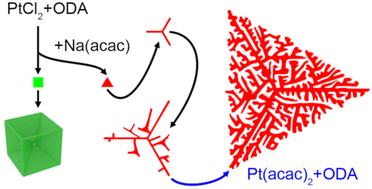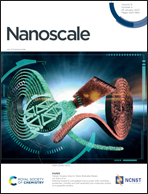Etching suppression as a means to Pt dendritic ultrathin nanosheets by seeded growth†
Abstract
2D ultrathin metal nanostructures are emerging materials displaying distinct physical and chemical properties compared to their analogues of different dimensionalities. Nanosheets of fcc metals are intriguing, as their crystal structure does not favour a 2D configuration. Thanks to their increased surface-to-volume ratios and the optimal exposure of low-coordinated sites, 2D metal nanostructures can be advantageously exploited in catalysis. Synthesis approaches to ultrathin nanosheets of pure platinum are scarce compared to other noble metals and to Pt-based alloys. Here, we present the selective synthesis of Pt ultrathin nansosheets by a simple seeded-growth method. The most crucial point in our approach is the selective synthesis of Pt seeds comprising planar defects, a main driving force for the 2D growth of metals with fcc structure. Defect engineering is employed here, not in order to disintegrate, but for conserving the defect comprising seeds. This is achieved by in situ elimination of the principal etching agent, chloride, which is present in the PtCl2 precursor. As a result of etching suppression, twinned nuclei, that are selectively formed during the early stage of nucleation, survive and grow to multipods comprising planar defects. Using the twinned multipods as seeds for the subsequent 2D overgrowth of Pt from Pt(acac)2 yields ultrathin dendritic nanosheets, in which the planar defects are conserved. Using phenylacetylene hydrogenation as a model reaction of selective hydrogenation, we compared the performance of Pt nanosheets to that of a commercial Pt/C catalyst. The Pt nanosheets show better stability and much higher selectivity to styrene than the commercial Pt/C catalyst for comparable activity.

- This article is part of the themed collection: Celebrating International Women’s Day: Women in Nanoscience


 Please wait while we load your content...
Please wait while we load your content...